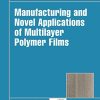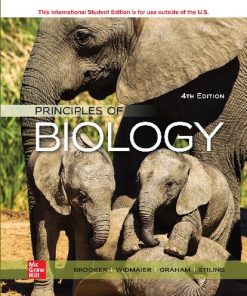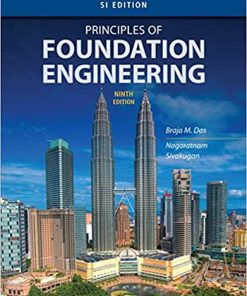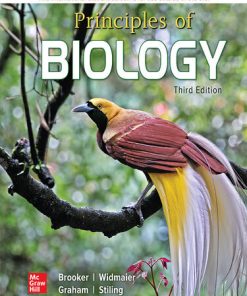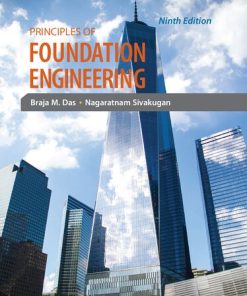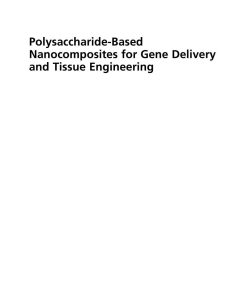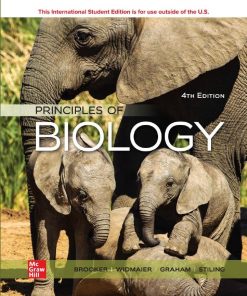Principles of Tissue Engineering 1st edition by Robert Lanza 0128214015 9780128214015
$50.00 Original price was: $50.00.$25.00Current price is: $25.00.
Principles of Tissue Engineering 1st edition by Robert Lanza – Ebook PDF Instant Download/DeliveryISBN: 0128214015 9780128214015
Full download Principles of Tissue Engineering 1st edition after payment.
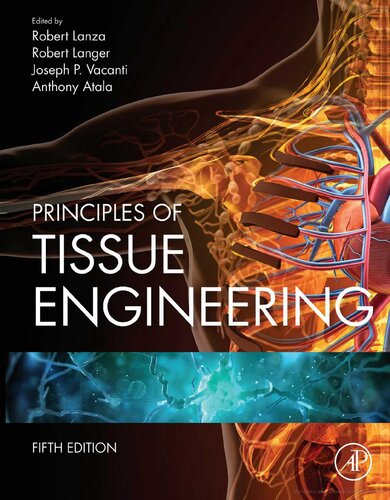
Product details:
ISBN-10 : 0128214015
ISBN-13 : 9780128214015
Author : Robert Lanza
Now in its fifth edition, Principles of Tissue Engineering has been the definite resource in the field of tissue engineering for more than a decade. The fifth edition provides an update on this rapidly progressing field, combining the prerequisites for a general understanding of tissue growth and development, the tools and theoretical information needed to design tissues and organs, as well as a presentation by the world’s experts of what is currently known about each specific organ system.
As in previous editions, this book creates a comprehensive work that strikes a balance among the diversity of subjects that are related to tissue engineering, including biology, chemistry, material science, and engineering, among others, while also emphasizing those research areas that are likely to be of clinical value in the future.
Principles of Tissue Engineering 1st Table of contents:
1 Tissue engineering: current status and future perspectives
Clinical need
Current state of the field
Smart biomaterials
Cell sources
Embryonic stem cells
Induced pluripotent stem cells
Adult stem cells
Whole organ engineering
Biofabrication technologies
Electrospinning
Inkjet three-dimensional bioprinting
Extrusion three-dimensional bioprinting
Spheroids and organoids
Imaging technologies
Tissue neovascularization
Bioreactors
Organ-on-a-chip and body-on-a-chip
Integration of nanotechnology
Current challenges
Future directions
Smart biomaterials
Cell sources
Embryonic stem cells
Induced pluripotent stem cells
Adult stem cells
Whole organ engineering
Biofabrication technologies
Tissue neovasculatization
Bioreactors
Integration of nanotechnology
Conclusions and future challenges
References
Further reading
2 From mathematical modeling and machine learning to clinical reality
Introduction
Modeling stem cell dynamics
Positive feedback–based molecular switches
Variability in stem cell populations
Modeling tissue growth and development
Monolayer tissue growth in vitro
Tissue growth on complex surfaces in vitro
Three-dimensional tissue growth in vitro
Pattern formation
Machine learning in tissue engineering
Supervised methods
Unsupervised methods
Machine learning of cellular dynamics
Regulatory network inference
From mathematical models to clinical reality
References
3 Moving into the clinic
Introduction
Current state of tissue engineering
Pathway for clinical translation
Regulatory considerations for tissue engineering
Conclusion
Acknowledgment
References
Further reading
One: The basis of growth and differentiation
4 Molecular biology of the cell
The cell nucleus
Control of gene expression
Transcription factors
Other controls of gene activity
The cytoplasm
The cytoskeleton
Microtubules
Microfilaments
Small GTPases
The cell surface
Cell adhesion molecules
Extracellular matrix
Signal transduction
Growth and death
Culture media
Cells in tissues and organs
Cell types
Tissues
Organs
Reference
Further reading
General
Chromatin
Signaling, general
Cytoskeleton, adhesion molecules and extracellular matrix
5 Molecular organization of cells
Introduction
Molecules that organize cells
Changes in cell–cell adhesion
Changes in celleextracellular matrix adhesion
Changes in cell polarity and stimulation of cell motility
Invasion of the basal lamina
The epithelial–mesenchymal transition transcriptional program
Transcription factors that regulate epithelial–mesenchymal transition
Regulation at the promoter level
Posttranscriptional regulation of epithelial–mesenchymal transition transcription factors
Molecular control of the epithelial–mesenchymal transition
Ligand-receptor signaling
Growth factor-β pathway
Wnt pathway
Signaling by receptor tyrosine kinase ligands
Notch pathway
Hedgehog pathway
Additional signaling pathways
A model for epithelial–mesenchymal transition induction
Conclusion
List of acronyms and abbreviations
Glossary
References
6 The dynamics of cell–extracellular matrix interactions, with implications for tissue engineering
Introduction
Historical background
Extracellular matrix composition
Receptors for extracellular matrix molecules
Cell–extracellular matrix interactions
Development
Adhesion and migration
Proliferation
Differentiation
Apoptosis
Wound healing
Adhesion and migration
Proliferation
Differentiation
Apoptosis
Signal transduction events during cell–extracellular matrix interactions
Relevance for tissue engineering
Avoiding a strong immune response that can cause chronic inflammation and/or rejection
Creating the proper substrate for cell survival and differentiation
Providing the appropriate environmental conditions for tissue maintenance
References
7 Matrix molecules and their ligands
Introduction
Collagens
Fibrillar collagens
Fibril-associated collagens with interrupted triple helices (FACIT)
Basement membrane–associated collagens
Other collagens
Major adhesive glycoproteins
Fibronectin
Laminin
Elastic fibers and microfibrils
Other adhesive glycoproteins and multifunctional matricellular proteins
Vitronectin
Thrombospondins
Tenascins
Proteoglycans
Hyaluronan and lecticans
Perlecan
Small leucine-rich repeat proteoglycans and syndecans
Conclusion
References
8 Morphogenesis and tissue engineering
Introduction to tissue morphogenesis
Biology of tissue morphogenesis
Morphogens as bioactive signaling molecules during morphogenesis
The extracellular matrix as a key regulator of tissue morphogenesis
Cell–cell interactions during tissue morphogenesis
Tissues as integrated systems in the body
Engineering tissue morphogenesis
Cells as building units in tissue engineering
Biomaterial scaffolds as artificial extracellular matrices
Morphogens as signaling cues in tissue engineering
Tissue remodeling in healthy and diseased environments
Current focuses and future challenges
References
9 Gene expression, cell determination, differentiation, and regeneration
Introduction
Determination and differentiation
MyoD and the myogenic regulatory factors
Negative regulators of development
MicroRNAs—regulators of differentiation
Pax in development
Satellite cells in skeletal muscle differentiation and repair
Tissue engineering—repairing muscle and fostering regeneration by controlling determination and di
Conclusion
References
Two: In vitro control of tissue development
10 Engineering functional tissues: in vitro culture parameters
Introduction
Key concepts for engineering functional tissues
Fundamental parameters for engineering functional tissues
Fundamental criteria for engineering functional tissues
Importance of in vitro studies for engineering functional tissues
In vitro studies relevant to tissue engineering and regenerative medicine
In vitro platforms relevant for high throughput screening of drugs and other agents
Influence of selected in vitro culture parameters on the development and performance of engineered t
Culture duration
Cartilage tissue engineering
Cardiac tissue engineering
Biomaterials
Cartilage tissue-engineering biomaterials
Fiber-reinforced constructs for cartilage repair
Stratified and osteochondral constructs for cartilage repair
Bioinductive and bioactive scaffolds
Cardiac tissue–engineering biomaterials
Bioreactors and growth factors
Cell seeding
Construct cultivation
Cartilage tissue-engineering bioreactors
Cardiac tissue-engineering bioreactors
Bioreactors and mechanical forces
Effects of hydrodynamic forces
Effects of mechanical tension, compression, and shear loading
Mechanical effects on engineered cartilage tissue
Electromechanical effects on engineered myocardium
Conclusion
Acknowledgments
References
Further reading
11 Principles of bioreactor design for tissue engineering
Introduction
Macrobioreactors
Design principles
Mass transport
Physiological biomimicry cues
Cell environment
Sustainable bioreactors
Cell manufacturing quality attributes and process analytics technology
Future outlook
Microgravity bioreactor
Real-time assessment in the bioreactor
Microbioreactors
Design principles
Flow rheology
Cell microenvironment
Integration of multiple compartments
Types of microreactors
Components and integration into microreactors
Applications
Drug testing and screening
Experimental models of disease
Prognostic/diagnostic tools
Summary
Acknowledgments
References
12 Regulation of cell behavior by extracellular proteins
Introduction
Thrombospondin-1
Thrombospondin-2
Tenascin-C
Osteopontin
Secreted protein acidic and rich in cysteine
Conclusion
References
13 Cell and matrix dynamics in branching morphogenesis
Introduction
The basis of branching morphogenesis
Branching morphogenesis in the lung
Branching morphogenesis in the salivary gland
Branching morphogenesis in the kidney
Contributions of other cell types
MicroRNAs in branching morphogenesis
Extracellular matrix components in branching morphogenesis
Laminin
Collagen
Heparan sulfate proteoglycan
Fibronectin and integrins
Basement membrane microperforations
Mathematical and computational models
Geometry
Mechanical forces
Signaling mechanisms
Conclusion
Acknowledgments
References
14 Mechanobiology, tissue development, and tissue engineering
Introduction
Mechanical forces in biological systems
Tension
Compression
Fluid shear
Cellular mechanosensing
The cytoskeleton
Stretch-activated ion channels
Cell–cell adhesions
Cell–substrate adhesions
The extracellular matrix
Cellular effects of mechanotransduction
Substrate adhesion, spreading, and migration
Cell–cell interactions in collectives
Proliferation and differentiation
Mechanotransduction in biological phenomena
Wound healing
Tissue morphogenesis
Cancer metastasis
Mechanobiology in tissue engineering
Bone-implant design
Organs-on-a-chip
References
Three: In Vivo Synthesis of Tissues and Organs
15 In vivo engineering of organs
Introduction
Historical context
Nature’s approach to cellular differentiation and organization
Conceptual framework of the in vivo bioreactor
In vivo bone engineering—the bone bioreactor
In vivo cartilage engineering
Induction of angiogenesis using biophysical cues—organotypic vasculature engineering
De novo liver engineering
Repairing brain tissue through controlled induction of reactive astrocytes
Conclusions and outlook
References
Four: Biomaterials in tissue engineering
16 Cell interactions with polymers
Methods for characterizing cell interactions with polymers
In vitro cell culture methods
Adhesion and spreading
Migration
Aggregation
Cell phenotype
High-throughput methods for the characterization of cell–polymer interactions
In vivo methods
Cell interactions with polymers
Protein adsorption to polymers
Effect of polymer chemistry on cell behavior
Synthetic polymers
Surface modification
Biodegradable polymers
Synthetic polymers with adsorbed proteins
Hybrid polymers with immobilized functional groups
Electrically charged or electrically conducting polymers
Influence of surface morphology on cell behavior
Use of patterned surfaces to control cell behavior
Cell interactions with polymers in suspension
Cell interactions with three-dimensional polymer scaffolds and gels
Cell interactions unique to the in vivo setting
Inflammation
Fibrosis and angiogenesis
References
17 Polymer scaffold fabrication
Introduction
Design inputs: materials, processing, and cell types
Materials and inks
Processing and cell viability
Cell types and biological interactions
Assessment of cell viability and activity
3D printing systems and printer types
Inkjet printing
Extrusion printing
Laser-assisted bioprinting
Stereolithography
Open source and commercial 3D printing systems
Print outputs: patterning, resolution, and porous architecture
Printing/patterning of multiple inks
Print resolution
Porous architecture
Assessment of scaffold fidelity
Printing applications: vascularized and complex, heterogeneous tissues
Conclusion
Acknowledgments
Abbreviations
References
18 Biodegradable polymers
Introduction
Biodegradable polymer selection criteria
Biologically derived polymers
Peptides and proteins
Collagen
Gelatin
Elastin
Keratin
Silk
Proteoglycans
Biomimetic materials
Polysaccharides
Cellulose
Starch
Alginate
Gellan gum
Glycosaminoglycans
Chitosan
Polyhydroxyalkanoates
Polynucleotides
Synthetic polymers
Aliphatic polyesters
Polyglycolide, polylactide, and their copolymers
Poly(ɛ-caprolactone)
Poly(p-dioxanone)
Poly(ortho esters)
Aliphatic polycarbonates
Biodegradable polyurethanes
Polyanhydrides
Polyphosphazenes
Poly(amino acids) and pseudo-poly(amino acids)
Combinations (hybrids) of synthetic and biologically derived polymers
Using polymers to create tissue-engineered products
Barriers: membranes and tubes
Gels
Matrices
Conclusion
References
19 Three-dimensional scaffolds
Introduction
Three-dimensional scaffold design and engineering
Mass transport and pore architectures
Mechanics
Electrical conductivity
Surface properties
Surface chemistry
Surface topography
Temporal control
Scaffold degradation
Delivery of soluble bioactive factors
Spatial control
Conclusion
References
Five: Transplantation of engineered cells and tissues
20 Targeting the host immune response for tissue engineering and regenerative medicine applications
Introduction
Immune cells and their roles in building tissues after injury
Neutrophils
Eosinophils
Macrophages
Dendritic cells
T and B cells
Specialized immune cell functions beyond host defense
Tissue engineering/regenerative medicine strategies as immunotherapy
Future considerations for immune cell targeting tissue engineering/regenerative medicine therapies
References
Further reading
21 Tissue engineering and transplantation in the fetus
Introduction
Rationale for in utero therapies
In utero transplantation
Early murine experiments with in utero transplantation
In utero transplantation experiments in large preclinical animal models
Barriers to in utero transplantation success
Clinical experience with in utero transplantation
Rationale for in utero gene therapy
Hemophilia A as a model genetic disease for correction by in utero gene therapy
The need for better hemophilia A treatments
Preclinical animal models for hemophilia A and recent clinical successes
Sheep as a preclinical model of hemophilia A
Feasibility and justification for treating hemophilia A prior to birth
Mesenchymal stromal cells as hemophilia A therapeutics
Preclinical success with mesenchymal stromal cell–based hemophilia A treatment
Risks of in utero gene therapy
Genomic integration–associated insertional mutagenesis
Potential risk to fetal germline
Conclusion and future directions
References
22 Challenges in the development of immunoisolation devices
Introduction
Rejection and protection of transplanted cells and materials
Rejection pathways
Cellular nutrition
Therapeutic cells
Primary cells
Immortalized cell lines
Stem cells
Device architecture and mass transport
Transplantation site
Improving oxygenation of immunoprotected cells
Controlling immune responses to implanted materials
Steps in the foreign body reaction
The role of geometry in the foreign body reaction
Tuning chemical composition to prevent attachment
Directing immune cell behavior in the transplant niche
References
Six: Stem cells
23 Embryonic stem cells
Introduction
Approaches to human embryonic stem cell derivation
Maintenance of human embryonic stem cell
Subculture of human embryonic stem cell
Nuances of human embryonic stem cell culture
Directed differentiation
Safety concerns
Conclusion
Acknowledgment
References
24 Induced pluripotent stem cell technology: venturing into the second decade
Disease modeling
Drug discovery
Stem cell–based therapeutic development
Concluding remarks
Acknowledgements
References
25 Applications for stem cells
Introduction
Reprogramming of somatic cells into induced pluripotent stem cells
Epigenetic remodeling
Reprogramming techniques
Induced transdifferentiation
Genomic stability
Applications of induced pluripotent stem cells
Disease modeling
Challenges and future possibilities in disease modeling
Disease-modifying potential of induced pluripotent stem cells
Other applications for induced pluripotent stem cells
Conclusion
List of acronyms and abbreviations
References
26 Neonatal stem cells in tissue engineering
Introduction
Stem cells
Embryonic stem cells
Induced pluripotent stem cells
Perinatal stem cells
Cells from the umbilical cord, amniotic membrane, and placenta
Umbilical cord blood–derived cells
Amniotic fluid stem cells
Scaffolding specifics in fetal and neonatal tissue engineering
Synthetic materials
Natural materials
Relevance to prenatal therapy
Immunology
Physiology
Conditions of interest
Spina bifida
Gastroschisis
Congenital diaphragmatic hernia
Esophageal atresia
Congenital heart disease
Congenital airway anomalies
Bladder
Bone and bone marrow
Conclusion
References
27 Embryonic stem cells as a cell source for tissue engineering
Introduction
Maintenance of embryonic stem cells
Directed differentiation
Genetic reprogramming
Microenvironmental cues
Three-dimensional versus two-dimensional cell culture systems
High-throughput assays for directing stem cell differentiation
Physical signals
Isolation of specific progenitor cells from embryonic stem cells
Transplantation
Transplantation and immune response
Future prospects
Conclusion
Acknowledgments
Conflicts of interest
References
Further reading
Seven: Gene therapy
28 Gene therapy
Strategies of gene therapy
Ex vivo versus in vivo gene therapy
Ex vivo
In vivo
Chromosomal versus extrachromosomal placement of the transferred gene
Gene transfer vectors
Nonviral vectors
Adenovirus
Adeno-associated virus
Retrovirus
Lentivirus
Cell-specific targeting strategies
Targeting of Ad vectors
Targeting of adeno-associated virus vectors
Targeting of retroviral and lentiviral vectors
Regulated expression of the transferred gene
Using gene transfer vectors for gene editing
Combining gene transfer with stem-cell strategies
Gene transfer to stem cells
Gene transfer to control uncontrolled stem-cell growth
Gene transfer to instruct stem-cell differentiation
Gene transfer to regulate gene expression
Challenges to gene therapy for tissue engineering
Acknowledgments
References
29 Gene delivery into cells and tissues
Introduction
Fundamentals of gene delivery
Biodistribution, targeting, uptake, and trafficking
Tissue biodistribution/targeting
Cellular uptake and intracellular trafficking
Viral nucleic acid delivery
Introduction to viral gene therapy
Types of viral vectors
Engineering viral vectors
Nonviral nucleic acid delivery
Introduction to nonviral nucleic acid delivery
Oligonucleotide modifications
Conjugates
Synthetic polymers
Polymers derived from natural sources or monomers
Lipid-based delivery systems
Inorganic nanoparticles
High-throughput screening
Engineering tissues with gene delivery
Introduction to engineering tissue with gene delivery
Viral delivery to engineer tissues
Nonviral delivery from scaffolds
Nucleic acid delivery for tissue engineering advances into the clinic
Future challenges
Outlook
Acknowledgments
References
Eight: Breast
30 Breast tissue engineering: implantation and three-dimensional tissue test system applications
Introduction
Breast anatomy and development
Breast cancer diagnosis and treatments
Breast reconstruction
Synthetic implants
Tissue flaps
Cell transplants
Cellular scaffolds
Cell types and related challenges
Scaffolds
Synthetic materials
Naturally derived materials
Therapeutic scaffolds
Injectable scaffolds
Combination scaffolds
Strategies to enhance the vascularization of engineered tissue
Special considerations
Breast cancer modeling
Animal models
Breast tissue test systems
In silico breast cancer models
Concluding remarks
Acknowledgement
References
Nine: Cardiovascular system
People also search for Principles of Tissue Engineering 1st:
basic principles of tissue engineering
principles of tissue engineering pdf
principles of tissue engineering ppt
principles of tissue engineering 4th edition
principles of tissue engineering 5th edition
Tags:
Principles,Tissue Engineering,Robert Lanza,rapidly progressing
You may also like…
Biology and other natural sciences - Biology
Biology and other natural sciences - Biology
Business & Economics
Engineering - Bioengineering
Materials for Biomedical Engineering: Nanobiomaterials in Tissue Engineering 1st Edition
Engineering
Polysaccharide-Based Nanocomposites for Gene Delivery and Tissue Engineering Showkat Ahmad Bhawani
Biology and other natural sciences - Biology


